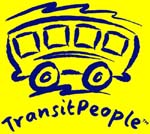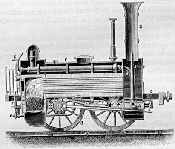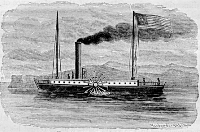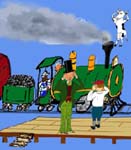
|
Richard Trevithick built the first locomotive. A locomotive is a vehicle with an engine that runs on railroad tracks. It pulls other vehicles behind it. Trevithick's locomotive could pull seventy people along ten miles of railroad tracks. It was powered by a steam engine.
A steam engine runs on boiling water. A fire of coal or wood heats the water, and the boiling water makes steam. The force of the steam pushes a piston up and down. Gears change the motion of the piston into the round-and-round motion of the wheels on tracks. People also put steam engines on boats. Some of the first steamships traveled the Mississippi River. Instead of turning wheels round and round, the engines turned giant paddlewheels, like the one on this boat. Later on steamships used propellers.
Not everyone liked the new ways of traveling. One scientist thought that high speed train travel could make your brains fall out. Some farmers didn't like trains because the noise and smoke scared cows and horses. Still, lots of people wanted to use trains and steamships to go long distances. In 1840, an Englishman started the first steamship service across the Atlantic Ocean. Soon there were other services carrying mail, people and cargo across other oceans, too.
The first railroad line to carry people opened in 1825. After that railroad lines opened all over the world. The French built one in 1830; the Germans, in 1835. The United States built a railroad that went all the way across the country, from New York to Sacramento. Railroads and steamships changed the way people lived. People could buy fresh milk and vegetables that the trains carried from faraway places. They could visit faraway places too, or live in the country and "commute" into the city by train. Steamships made it possible for millions of people to travel to live in other countries. Trains also changed the way people traveled in cities.
Before trains, horses and mules pulled trolley cars on tracks. These didn't go very fast. Sometimes the horse pulled the car off the tracks by accident, and everyone had to get out and push the car back on again! In the late 1800s, electric railways began to replace the horse trolleys. These were much faster. Now people could live much farther from where they worked, and commute by train.
Cities all over the world built public transit rail systems. London built the first underground system in 1863; it was followed by Budapest, and then by Boston and New York. In Los Angeles, a millionaire named Henry Huntington built the Pacfic Electric railway: the biggest public train electric railway system in the world.
Some of these systems were much bigger than the public transit systems these cities have today. The reason was simple: it was the only way people had of going places quickly! Most people wanted to live near a transit stop. Business people made lots of money building transit systems to serve them. But even as new trains were built and city engineers were laying down new miles of railroad track, a new machine was being created that would completely change the way people traveled all over again. The car.
|






